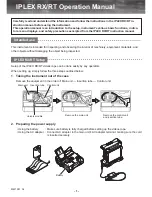5 - 1
Transpector XPR 3+ Operating Manual
Chapter 5
Transpector XPR 3+ Operation and Best Known
Methods
5.1 Introduction
Once the Transpector XPR 3+ Sensor, Electronics Module, Isolation Valve, and
Pirani Interlock are installed, the isolation valve should be opened to allow
Transpector XPR 3+ to obtain high vacuum. It is strongly recommended that
Transpector XPR 3+ be kept under high vacuum conditions for at least eight hours
before the filament is turned on. It is also recommended that Transpector XPR 3+
be baked out with the supplied heating jacket (which operates at 150 °C), for a
period of at least eight hours. This eight hour minimum bakeout is required to
reduce residual water vapor levels that may be higher due to local surface
outgassing effects. These recommendations should be followed whenever
Transpector XPR 3+ Sensor is exposed to atmosphere for long periods of time and
will serve to increase sensor life.
CAUTION
Do not turn on electron multiplier high voltage at sensor
temperatures above 150 °C. Permanent damage to the
electron multiplier could result.
WARNING
During or immediately after bakeout, the heating jacket
and metal surfaces in the vicinity of the heating jacket
may be hot. These surfaces may exceed 100 °C at the
maximum ambient operating temperature (i.e., 50 °C),
which will cause burns if touched directly without using
the proper personal protection equipment.
Table 5-1 Transpector XPR 3+ Sensor maximum bakeout temperature
Sensor
Maximum
Operating
Temperature
Maximum Bakeout
Temperature
Electronics Removed
Transpector XPR 3+
150 °C
200 °C


















